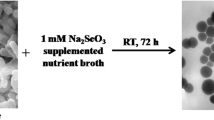Abstract
Biological dissimilatory reduction of selenite (SeO3 2−) to elemental selenium (Se0) is common, but the mineral formation and the biogenic process remain uncertain. In this study, we examined the Se0 formation during the selenite bioreduction by Bacillus licheniformis SeRB-1 through transmission electron microscope (TEM), energy-dispersive spectrometry (EDS) and X-ray absorption fine structure (XAFS) techniques. Results showed that the reduction process occurred mostly during the exponential phase and early stationary phase, whilst the elemental selenium was produced in these periods. From the TEM images and polyacrylamide gel electropheresis, it is known that the Se0 granule formation is a biologically-induced type, and the cell envelopes are the main biomineralization positions, and particles may go through a process from nucleation to crystallization, under the control of microbes. In fact, the minerals are spherical nanoparticles, occurring as a microcrystal or amorphous form. It is vital to recognize which kinds of proteins and/or polysaccharides act as a template to direct nanoparticle nucleation and growth? This should focus for further studies. This study may shed light on the process of formation of Se(0) nanosphere.
Similar content being viewed by others
References Cited
Boskey, A. L., 1998. Biomineralization: Conflicts, Challenges, and Opportunities. Journal of Cellular Biochemistry, 30/31(Suppl.): 83–91
Butler, C. S., Debieux, C. M., Dridge, E. J., et al., 2012. Biomineralization of Selenium by the Selenate-Respiring Bacterium Thauera Selenatis. Biochemical Society Transactions, 40: 1239–1243
Chen, J., Yao, S., 2005. Geomicrobiology and Its Progress. Geological Journal of China Universities, 11: 154–166 (in Chinese with English Abstract)
Debieux, C. M., Dridge, E. J., Mueller, C. M., et al., 2011. A Bacterial Process for Selenium Nanosphere Assembly. Proceedings of the National Academy of Sciences of the United States of America, 108: 13480–13485
Dobias, J., Suvorova, E. I., Bernier-Latmani, R., 2011. Role of Proteins in Controlling Selenium Nanoparticle Size. Nanotechnology, 22(19): 195605
Dowdle, P. R., Oremland, R. S., 1998. Microbial Oxidation of Elemental Selenium in Soil Slurries and Bacterial Cultures. Environmental Science & Technology, 32: 3749–3755
Ehrlich, H. L., Newman, D. K., 2008. Geomicrobiology. CRC Press: Boca Raton, FL. 656
Frankel, R. B., Bazylinski, D. A., 2003. Biologically Induced Mineralization by Bacteria. Biomineralization, 54: 95–114
Kaur, G., M., Iqbal, M., Bakshi, M. S., 2009. Biomineralization of Fine Selenium Crystalline Rods and Amorphous Spheres. Journal of Physical Chemistry C, 113: 13670–13676
Kessi, J., Hanselmann, K. W., 2004. Similarities between the Abiotic Reduction of Selenite with Glutathione and the Dissimilatory Reaction Mediated by Rhodospirillum Rubrum and Escherichia Coli. Journal of Biological Chemistry, 279: 50662–50669
Kessi, J., Ramuz, M., Wehrli, E., et al., 1999. Reduction of Selenite and Detoxification of Elemental Selenium by the Phototrophic Bacterium Rhodospirillum Rubrum. Applied and Environmental Microbiology, 65: 4734–4740
Knoll, A. H., 2003. The Geological Consequences of Evolution. Geobiology, 1: 3–14
Lenz, M., Kolvenbach, B., Gygax, B., et al., 2011. Shedding Light on Selenium Biomineralization: Proteins Associated with Bionanominerals. Applied and Environmental Microbiology, 77: 4676–4680
Lenz, M., Lens, P. N. L., 2009. The Essential Toxin: The Changing Perception of Selenium in Environmental Sciences. Science of the Total Environment, 407: 3620–3633
Lei, L., 2010. Microbial Geochemistry of Selenium in Se-Rich Carbonaceous Mudstone from Yutangba, Enshi of Hubei Province in China: [Dissertation]. Graduate University Chinese Academy of Sciences, Beijing (in Chinese with English Abstract)
Lloyd, J. R., Pearce, C. I., Coker, V. S., et al., 2008. Biomineralization: Linking the Fossil Record to the Production of High Value Functional Materials. Geobiology, 6: 285–297
Lowenstam, H. A., 1981. Minerals Formed by Organisms. Science, 211: 1126–1131
Lu, A. H., 2007. Mechanisms of Environmental Response to Biomineralization. Geological Journal of China Universities, 13: 613–620 (in Chinese with English Abstract)
Mann, S., 1993. Biomineralization—The Hard Part of Bioinorganic Chemistry. Journal of the Chemical Society-Dalton Transactions, 1–9. doi:10.1039/DT9930000001
Mann, S., 2001. Biomineralization: Principles and Concepts in Bioinorganic Materials Chemistry. Oxford University Press, New York.
Oremland, R. S., Herbel, M. J., Blum, J. S., et al., 2004. Structural and Spectral Features of Selenium Nanospheres Produced by Se-Respiring Bacteria. Applied and Environmental Microbiology, 70: 52–60
Pearce, C. I., Pattrick, R. A. D., Law, N., et al., 2009. Investigating Different Mechanisms for Biogenic Selenite Transformations: Geobacter Sulfurreducens, Shewanella Oneidensis and Veillonella Atypica. Environmental Technology, 30: 1313–1326
Rehr, J. J., Ankudinov, A. L., 2001. Progress and Challenges in the Theory and Interpretation of X-Ray Spectra. Journal of Synchrotron Radiation, 8: 61–65
Stolz, J. F., Oremland, R. S., 1999. Bacterial Respiration of Arsenic and Selenium. Fems Microbiology Reviews, 23: 615–627
Weiner, S., Dove, P. M., 2003. An Overview of Biomineralization Processes and the Problem of the Vital Effect. Biomineralization, 54: 1–29
Yuan, Y. Q., Zhu, J. M., Liu, C., et al., 2014. Three High-Reducing Selenite-Tolerance Bacteria from Se-Laden Carbonaceous Mudstone. Earth Science Frontiers, 21(1): http://www.cnki.net/kcms/detail/11.3370.P.20140108.20141634.20140002.html (in Chinese with English Abstract)
Author information
Authors and Affiliations
Corresponding author
Rights and permissions
About this article
Cite this article
Yuan, Y., Zhu, J., Liu, C. et al. Biomineralization of Se nanoshpere by Bacillus licheniformis . J. Earth Sci. 26, 246–250 (2015). https://doi.org/10.1007/s12583-015-0536-9
Received:
Accepted:
Published:
Issue Date:
DOI: https://doi.org/10.1007/s12583-015-0536-9




